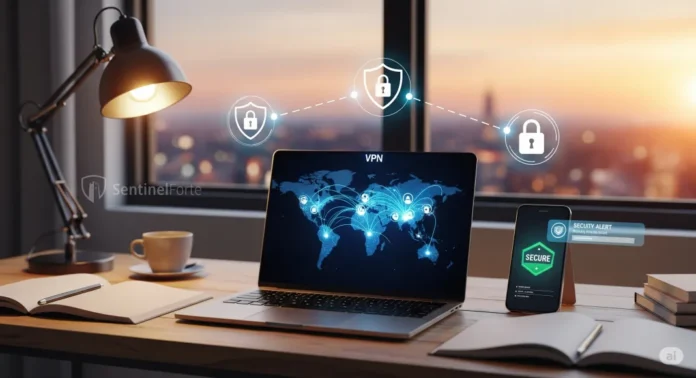Ensuring cybersecurity during remote work is critical to protecting sensitive business information and maintaining productivity. With increasing remote work setups globally, understanding cybersecurity best practices is no longer optional—it is a necessity to mitigate growing cyber threats.
Imagine finishing an important project on a peaceful afternoon at a local café, only to later discover unauthorized access to your corporate accounts. The serene environment and convenient connectivity of public Wi-Fi masked the hidden risks, leading you unknowingly into a cybercriminal’s trap. Stories like these have become alarmingly common as remote working has surged, highlighting why effective cybersecurity measures outside the office are crucial.
According to IBM’s 2024 Cost of a Data Breach Report, remote work setups have significantly increased cyber threats, with breaches costing companies an average of $4.8 million per incident. Remote environments, often less secure than corporate offices, provide easy targets for cybercriminals seeking vulnerabilities.
Understanding Remote Work Cybersecurity Risks
Remote work presents unique cybersecurity challenges. Employees accessing sensitive information from varied locations using diverse devices often lack robust security measures typically present within corporate networks. Common risks include phishing, malware infections, unsecured public Wi-Fi, device theft, and insecure home networks.
Cybercriminals frequently exploit these vulnerabilities through social engineering tactics, compromised passwords, or malicious attachments, often succeeding due to inadequate security training or improper device configurations.
Securing Home Networks and Personal Devices
Securing home networks and devices is foundational to remote work cybersecurity. Employees must ensure routers use WPA3 encryption and strong, unique passwords. Regularly updating router firmware further closes security gaps.
Personal devices used for work must be equipped with robust antivirus solutions and regularly updated software patches. Data encryption technologies, such as full-disk encryption, protect data even if devices are lost or stolen. Remote workers should also separate professional data from personal data to minimize exposure to breaches.
Safe Use of Public Wi-Fi
Public Wi-Fi is a convenient yet high-risk option for remote workers. Cybercriminals often exploit unsecured networks to intercept sensitive data. Always using a reputable Virtual Private Network (VPN) when connecting to public Wi-Fi is essential. VPNs encrypt data transmissions, significantly reducing vulnerability to cyberattacks.
Moreover, avoid accessing sensitive data or performing financial transactions on public Wi-Fi. Using cellular data, mobile hotspots, or secured personal hotspots is safer when handling sensitive information outside secure networks.
Essential Cybersecurity Training for Remote Workers
Regular cybersecurity training dramatically reduces the risk of cyber incidents. Employees must understand phishing tactics, recognize malicious links or attachments, and practice secure password habits. Training should include simulated phishing scenarios to sharpen awareness.
According to a 2024 Verizon Data Breach Investigations Report, organizations with regular cybersecurity training see nearly 70% fewer successful phishing attacks, underscoring training’s effectiveness in safeguarding remote workforces.
Implementing Multi-Factor Authentication (MFA)
Multi-factor authentication (MFA) significantly enhances security by requiring multiple verification methods beyond traditional passwords. Even if credentials are compromised, MFA prevents unauthorized access through additional verification layers, such as biometrics, authentication apps, or SMS codes.
Implementing MFA across all remote-access points, including email, cloud services, and corporate VPNs, is now considered standard cybersecurity practice. The 2024 Microsoft Security Report notes that MFA can block over 99% of account compromise attacks.
Role of Endpoint Security
Endpoint security tools play a critical role in remote work environments. They provide robust protection against malware, ransomware, and advanced persistent threats. Endpoint Detection and Response (EDR) systems actively monitor, detect, and respond to threats across devices, ensuring swift intervention and containment.
Organizations must adopt endpoint security solutions capable of managing diverse remote environments effectively, maintaining visibility and control over distributed devices.
Data Backup and Disaster Recovery
Regular data backups are essential for mitigating ransomware threats and ensuring business continuity during cyber incidents. Organizations must establish comprehensive backup strategies that regularly save critical data to secure, off-site cloud storage.
Reliable backup solutions provide peace of mind, allowing swift data recovery following cyber incidents without significant downtime or data loss.
Cybersecurity Policies and Compliance
Clearly defined remote work cybersecurity policies help ensure compliance and consistency across the workforce. Policies should detail acceptable use of technology, data handling procedures, reporting mechanisms for cyber incidents, and protocols for device management.
Regular policy reviews and updates, along with employee acknowledgment and training, reinforce cybersecurity awareness and adherence.
Staying Ahead: Proactive Cybersecurity Measures
Cybersecurity threats evolve continuously, requiring ongoing vigilance and adaptation. Regular risk assessments, continuous monitoring, and adopting proactive cybersecurity frameworks such as Zero Trust models significantly enhance resilience against cyber threats.
Remote work cybersecurity demands constant effort, but effective measures substantially reduce risk. Organizations and employees must remain proactive and informed, creating robust digital defenses even outside traditional office boundaries. Through ongoing vigilance, remote work can continue to offer flexibility without compromising critical security standards.

